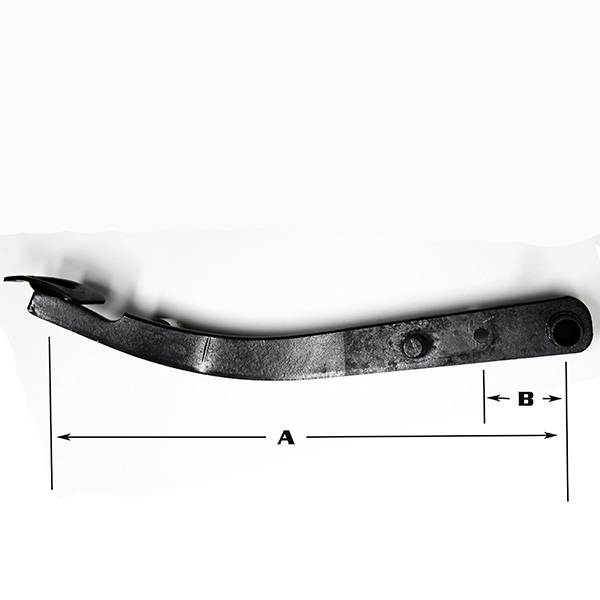
Proven Products
Race & Street Proven

have questions?
Race & Street Proven
We're here to help
Quick & Easy Install
We ship worldwide!





Brake Pedal Ratio
When converting your Power Brake System to a Manual Brake System, the first thing you need to consider is that you are removing the ‘Power’ from the brake system. In other words, there will be no more power assist, and you will have to rely on good old mechanical leverage to get the car stopped properly.
If you just install your UPR Manual Brake kit and hook it up without modifying the factory Power Brake Pedal, you will not physically be able to apply enough muscle to the pedal to get the car to stop like it should. Why? Brake Pedal Ratio.
Brake Pedal Ratio is the relationship between the brake pedal pivot point at the pedal mount, the brake pedal push rod location, and the brake pedal pad itself which makes up the leverage to produce pressure in the braking system. The power assist brake pedal would use a lower ratio since not as much leverage is required to achieve the correct brake system pressure (usually about 1200psi at the front caliper). When switching to manual, you will want more mechanical leverage to compensate for the loss of power assist. It’s the same principle as using a long breaker bar to loosen a stubborn bolt.
The UPR Manual Brake Kits use commonly available high-quality Strange Engineering 1.125 inch bore master cylinders which is a good fit for most disc brake systems. A good ballpark pedal ratio to shoot for with this size master cylinder is 6 or 6 1/2 to 1. Driver preference can determine if you want more or less leverage.
To determine your pedal ratio, start by measuring from the pivot point, (where the pedal assembly attaches to the body or frame) to the center of the brake pedal pad (A). Next, measure from the pivot point to the master cylinder push rod connection (B). Divide the first measurement (A) from the second (B) and the result is your pedal ratio. You will modify the pedal to get the desired ratio by moving the pushrod mounting point (generally going up). For example, let’s say the power brake pedal measures 13 inches from the center of the pivot to the center of the pedal pad, and the pushrod mount is 3 inches from the pivot 13÷3= 4.33 so we’ll say a 4 to one ratio. Not good for a manual set up. If we do some quick math to see what moving the hole up an inch will do, 13÷2= 6.5 now we’re right where we want to be. Mark the location, and that will be where you will weld the stud or drill and install a Grade 8 bolt to connect your brake push rod.

The UPR Billet Manual Brake Adapter Plates are machined to a common angle. You may need to add shims or washers behind the plate to achieve the desired pushrod angle for your application.
The UPR Manual Brake Kit is a great way to start on your custom brake system. Custom brake lines and other components like proportioning valves and fittings will be necessary.
UPR Products ships out all in stock orders via UPS or USPS the same day up till 5pm EST Monday through Friday. Orders received over the weekend will ship out on Monday. Tracking information is emailed to customers the evening after the package has been shipped out. Customers placing internet orders that have discrepancies or are out of stock will be contacted by phone or email.

Occasionally some parts that you have ordered will be out of stock. You will be called if any of the parts are out of stock and either hold the order till everything arrives or ship out what we have in stock and ship the remainder when it comes in based on your preference. You will not be charged for any items that are out of stock until the part is ready for shipping.
UPR Products does ship to Canada via USPS. Customers will go through the normal checkout process and our system will estimate the cost of shipping automatically based on your address. Please note - Additional Duties, taxes & Import Fee's may be charged upon arrival.
UPR Products ships internationally but due to frequently changing freight costs it is quoted per order. International customers should include both a phone number and email with their order so you can be contacted with a shipping quote.
If you need to return or exchange a product, please call us at 561-588-6630 within 30 days of receiving your order. We will issue a Return Merchandise Authorization (RMA) number which is required to process your return. Products should be shipped back to us via UPS, Fedex, USPS with a tracking number and insurance. All returned items must be in new condition and in the original packaging. Installed items cannot be returned. Contact us within the 30 days of receiving your order for any order issues. You are responsible for all return shipping charges and a 20% restocking fee will apply for any unapproved returns. Please check all parts for damage or defect when you receive your order and prior to installing or using the item.
The following items will not be accepted as returns. Tuners and tuning devices, opened and or installed clutches (removed from original packing), non-defective items that have been installed, gift certificates, catch cans, fuel pumps, fuel injectors, nitrous kits, shocks, struts. Issues with any of the listed items must be taken up directly with the manufacturer.
UPR Products offers a lifetime warranty against defects and failure on all products that we manufacture. Contact us at 561-588-6630 for further warranty information.
Magnaflow offers a Lifetime Warranty on their performance exhaust kits.
Register your Magnaflow Exhaust
For a Magnaflow Warranty Return, complete the following form and contact UPR Products at 561-588-6630.